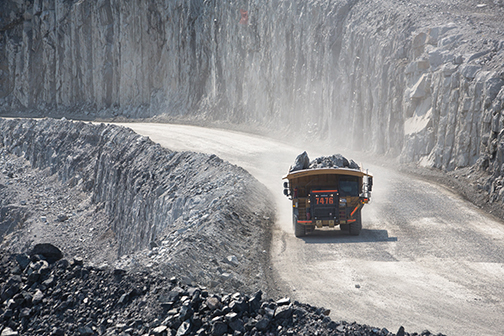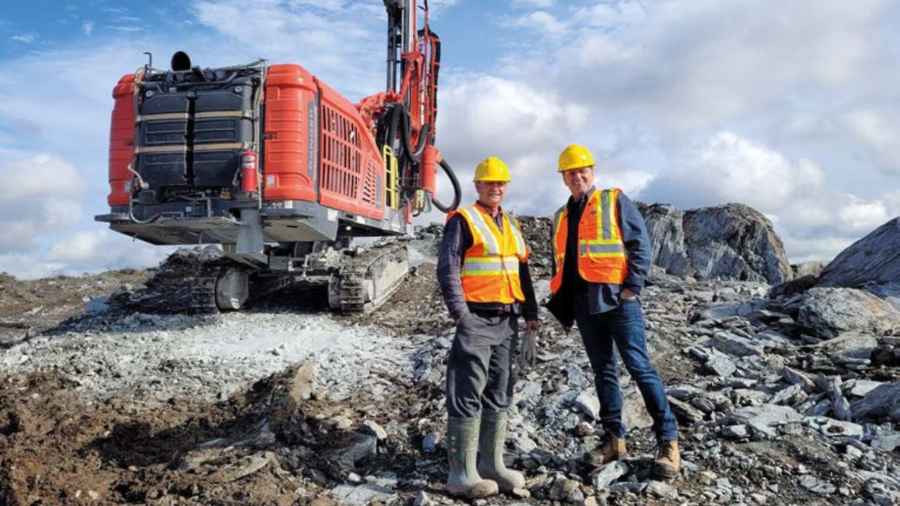St Marys Cement builds lasting legacy

The Bowmanville quarry, permitted for 4.5 million tonnes per year. (Credit: Cherisse Diaram)
Like all the vehicles at Votorantim Cimentos’ St Marys Cement plant and quarry in Bowmanville, east of Toronto, a new Caterpillar 993K wheel loader makes a strange noise when it backs up.
Instead of the customary loud beeping noise that most equipment makes – a safety feature to warn anyone who may be in proximity – vehicles at this operation make a loud squawking/barking sort of sound.
With the nearest neighbour only 250 metres away from the quarry, which operates six days a week and between 10 and 20 hours each day, some residents found the beeping noises too piercing and constant.
So the company devised a way to modify the sound so that it would be less bothersome to the neighbours while still meeting safety requirements.

The central control room at the plant. (Credit: Alisha Hiyate)
That’s just one example of the ways in which the Bowmanville quarry and cement plant tries to be a good neighbour.
While not as much can be done to muffle the noise from twice weekly blasting that takes place at the limestone quarry, the company does its best to minimize the impact on neighbours.
“We are right in the middle of a community, so we pay particular attention to the wind direction and the wind speed,” says quarry manager Ernie Hamilton. “The audible from a blast is usually what people notice the most.”
In addition to sharing the blasting schedule in the local paper and responding to community concerns, there are independently monitored stations scattered around the quarry that measure ground and air vibrations to ensure the operation stays within regulatory limits.
“There’s been a lot of work done over the years to try and minimize the noise,” says plant manager Jim Storey, who has worked in the industry for 28 years. “We’ve been here since 1968 and that’s how we’ve been extracting the rock through that period of time – through blasting.”
Being accustomed to the remote location of most mines, the urban location and ease of access to markets is the first thing that strikes Canadian Mining Journal about the Bowmanville facility. Just off highway 401, the plant also has onsite rail loading facilities and access to Lake Ontario for barge shipping.
St Marys Cement was founded in 1912 in the southern Ontario town of the same name. The company opened the Bowmanville plant at a time when the Greater Toronto Area (GTA) was rapidly expanding.
In fact, the plant, which will celebrate its 50th anniversary in 2018, has secured a place in local history. The facility supplied material for such Toronto landmarks as the CN Tower, Ripley’s Aquarium and Roy Thompson Hall – as well as the neighbouring Darlington nuclear plant. Its products have also been used to make countless roads and bridges in Southern Ontario, the GTA and the Great Lakes Region.
Now owned by international building materials supplier Votorantim Cimentos, which bought St Marys and its six locations (four in the U.S. and two in Canada) in 1991, the Bowmanville plant has roughly 130 employees, including 15 that work in the quarry.
During CMJ’s mid-February visit, the quarry wasn’t running at full tilt as the plant was closed for its annual maintenance shut down until early March.
But the quarry is where the cement-making process begins.
By mining standards, the Bowmanville quarry is small. Permitted for 4.5 million t/y, only about 3.45 million tonnes of rock was extracted last year. The majority of that, 2.84 million tonnes, went into the cement plant onsite. The remainder, 616,000 tonnes, was processed into aggregate for St Marys’ sister company, Canada Building Materials or CBM, which is also part of Votorantim Cimentos’ North American operations.
Currently at around 73 metres deep (at the top of Level 6), the quarry is permitted down to the 12th level, or 190 metres deep.
Drilling and blasting in the quarry usually takes place on Tuesdays and Thursdays, subject to weather and production demand. Each blast is aimed at freeing between 40,000 and 60,000 tonnes of limestone.
The large chunks of material are moved with the company’s fleet of six 100-ton haul trucks (both Caterpillar and Hitachi models), two 22-ton wheel loaders, and a new 30-ton Cat 993K loader – the largest in eastern Ontario.
The vehicles take the blasted material to the primary crusher, a 300-kW, 54” Fuller- Traylor gyratory crusher that can handle up to 1,500 t/h. The resulting -8” fragments are then processed down to -4” by a 450-kW Pennsylvania hammer crusher and then stored in one of three rock silos, based on the amount of calcium carbonate in the limestone.
“Two of the silos have low-carb rock and one has high-carb,” Hamilton says.
Underneath the silos, feeders transport the rock to the 3,000-kW raw mill that crushes it into a fine powder and combines it with other materials – shale or clay, iron and sand.
The chemistry of the materials is critical and the raw mill (an FLSmidth Atox 45 vertical spindle mill) has an analyzer that allows it to continuously sample and control the chemical mix of the material by running the feeders at variable speeds.
From there, the material goes into an FLSmidth preheater/precalciner kiln, which is fuelled primarily by coal.
The kiln can produce 230 tonnes of clinker per hour. Some clinker – a nodular material that must be finely ground and combined with gypsum to make cement is shipped to St Marys’ Detroit plant by barge.
The rest is further processed into cement using a 225 t/h Koppern roll press, three FLSmidth ball mills (up to 65 t/h) and separators, and then shipped in bulk by barge, truck or rail.
The whole process is highly automated and overseen from a central control room that is manned 24 hours a day.
As a bulk supplier, the plant makes up to 1.25 million tonnes of Portland cement annually – Type GU, Type I (both general use) and Type HE (early high-strength cement). Any further customization of cement is done at CBM’s Ready-Mix division. During the busy summer construction season, demand for product from the Bowmanville plant outstrips demand. To deal with these periods, the company invested in an expansion several years ago – not of the plant, but of its onsite storage capacity.
“One thing that you can do to increase the output of the plant is to run it longer, you don’t necessarily have to expand it,” Storey explains.
The plant has storage capacity for up to 210,000 tonnes of clinker and 120,000 tonnes of cement, allowing inventory to build in preparation for busy periods.
Energy leader
Unlike mines, quarries are dependent on local markets because of the cost of shipping their heavy products.
The growth of the Bowmanville operation has mirrored that of the communities around it, in particular the GTA. When it opened in 1968, the plant had a single wet kiln with a capacity of about 900 tonnes per day. In 1972, capacity was doubled with the addition of a second kiln.
A plant upgrade between 1988-91 again increased capacity, this time to 5,000 t/d as the wet kilns were replaced with a single preheater/precalciner kiln. At the time the biggest in North America, the kiln remains the biggest single-kiln operation in Canada. The kiln was last upgraded in 2000 to a capacity of 5,600 t/d.
What’s also changed over the years is the thought given to the plant’s energy consumption.
Producing cement is energy intensive – energy represents about 35% of the plant’s production costs. The kiln gets up to 1,500 °C – hot enough to melt steel. And the plant isn’t immune to the rising energy prices that have affected all of Ontario.
The operation pays spot prices for electricity which can vary from negative pricing on occasion, to over $300 per MWh. (During CMJ’s visit it was around $20-30 per MWh during the day.)
“Certainly, we are seeing that our electricity prices are on the rise,” Storey says. “So we’re fortunate that we’ve had an energy initiative that’s well established and well engrained in our culture for better than 10 years now. It’s paying dividends.”
Those efforts have saved well over 16 million kWh over the past decade.
In 2011, the operation demonstrated its leadership in this area by earning its ISO 50001 certification for energy management.
“We’re very proud that the Bowmanville plant was the first business ever in North America to receive this certification,”
Storey says. “As a company, our goal is to have a positive, long-term impact on people and our planet.”
To achieve the ISO 50001 certification, the company worked closely with Natural Resources Canada and a third-party registrar to manage the audit process and verify the plant’s continuous improvement over a three-year period.
The certification was a natural extension of efforts the plant was already making to save energy.
In 2005, the company started to pay even closer attention to its energy use and costs and, a year later, it formed an Energy Management Conservation Committee dubbed E=MC2. The committee established baseline measurements for the plant’s typical consumption of electricity and thermal energy, and found early success with low-cost measures such as installing occupancy sensors and monitoring and control software that would automatically turn off inactive equipment.
The company also hired Burlington, Ont.-based consultants 360 Energy to help it reduce its energy consumption. The effort earned St Marys the UK-based National Energy Foundation’s silver level Certification in Energy Excellence (CEE).
Next year, St Marys is installing a new, more efficient raw mill and a new scrubber to further reduce emissions. It’s also continuing work on the use of alternate fuels and using CO2 from the plant’s processes to grow algae to use as fuel.
The company has also worked with FLSmidth to reduce its SO2 emissions by producing its own hydrated lime, which is used as a cost-effective alkali to treat flue gas emissions from the cement plant. “Given the scale of our operations, it’s incumbent upon cement producers to constantly look for new and innovative ways to mitigate our environmental impact,” Storey says.
The efforts are in keeping with the company’s long-term point of view, expressed by its purpose statement, “Life is made to last.”
When the facility celebrates its semicentennial next year, it will still be less than halfway through its expected lifespan. At current production rates, the quarry is estimated to last for another 70 years.
When operations are done, the pit will become an extension of Lake Ontario – likely a deep-water marina.
“Today, the quarry supports the growth and construction of highly desirable developments. Eventually, as part of the Bowmanville lakefront, it will become one!” Hamilton says with a laugh.





Comments